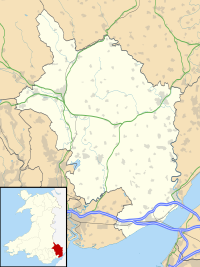Church in Monmouthshire, Wales
| All Saints Church | |
|---|---|
| Church of All Saints | |
 The entrance and bell gable The entrance and bell gable | |
 | |
| 51°44′17″N 2°56′39″W / 51.7381°N 2.9442°W / 51.7381; -2.9442 | |
| Location | Kemeys Commander, Monmouthshire |
| Country | Wales |
| Denomination | Church in Wales |
| Website | Official website |
| History | |
| Status | Parish church |
| Founded | c. 13th century |
| Architecture | |
| Functional status | Active |
| Heritage designation | Grade II* |
| Designated | 18 November 1980 |
| Architectural type | Church |
| Administration | |
| Diocese | Monmouth |
| Archdeaconry | Monmouth |
| Deanery | Raglan/Usk |
| Parish | Heart of Monmouthshire Ministry Area |
| Clergy | |
| Rector | The Reverend K J Hasler |
The Church of All Saints, Kemeys Commander, Monmouthshire, Wales, is a parish church with its origins in the 13th century. It is a Grade II* listed building.
History
The hamlets of Kemeys Commander and Kemeys Inferior formed part of the Monmouthshire estates of the Knights Templar. The Templars administered their holdings through commandery, accounting for the name of the hamlet. A reference to a church on the site dates from the 13th century, but the present building was constructed in the 15th century. The Lordship of Kemeys dates from the Middle Ages and was held by the Kemeys family until the estate was sold in the early 18th century.
The church was restored by Richard Creed in the late 19th century. At the time of the restoration, the vicar was The Rev. Herbert Sheppard M.A., of Clare College, Cambridge.
Architecture and description
The church is built of local limestone in the Perpendicular style. The entrance is through a timber porch and under a bell gable. The building has suffered from subsidence and the bell gable is off-vertical.
The church retains its original medieval rood screen and rood beam, one of few churches in southeast Wales that do so.
Notes
- ^ Cadw. "Church of All Saints, Gwehelog Fawr (Grade II*) (2626)". National Historic Assets of Wales. Retrieved 19 April 2022.
- Newman 2000, p. 260.
- "Kelly's Directory of Monmouthshire, 1901". Retrieved 31 March 2017.
- ^ Newman 2000, p. 259.
- "All Saints, Kemeys Commander (307345)". Coflein. RCAHMW. Retrieved 19 April 2022.
- "GGAT01812g". Cofiadurcahcymru.org.uk. Retrieved 31 March 2017.
- Newman 2000, p. 25: "At Kemeys Commander the screen and rood beam remain, and were clearly constructed together with the fabric of the little church".
- Kenyon, John R.; Williams, Diane M. (2006). Cardiff: Architecture and Archaeology in the Medieval Diocese of Llandaff. British Archaeological Association. ISBN 978-1-904350-80-4.
reprinted as Kenyon, John R.; Williams, Diane M. (2020). Cardiff : architecture and archaeology in the medieval diocese of Llandaff. Abingdon, Oxon: Routledge. ISBN 9781000161076.
References
- Newman, John (2000). Gwent/Monmouthshire. The Buildings of Wales. London: Penguin. ISBN 0-14-071053-1.
